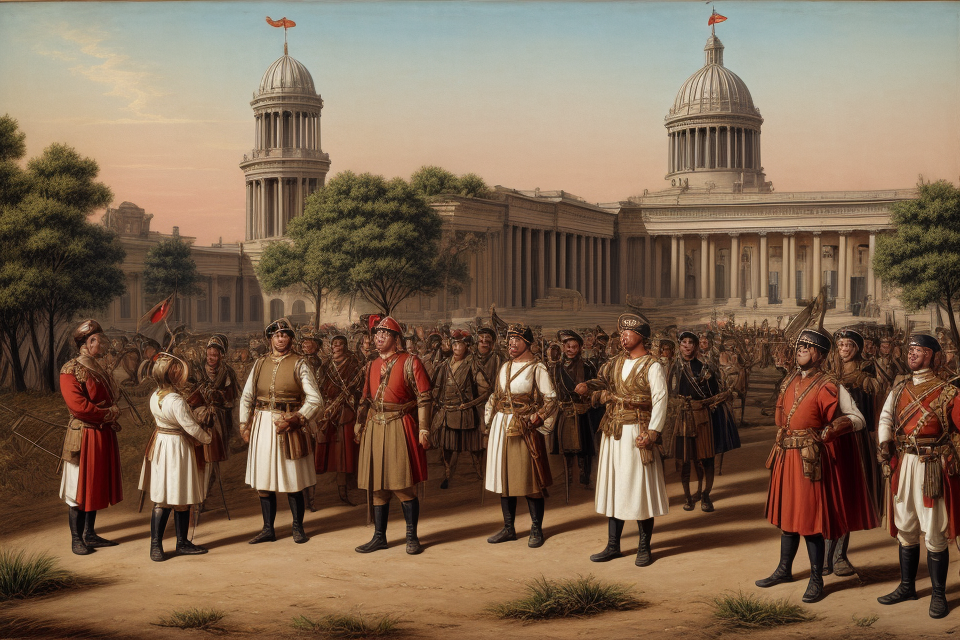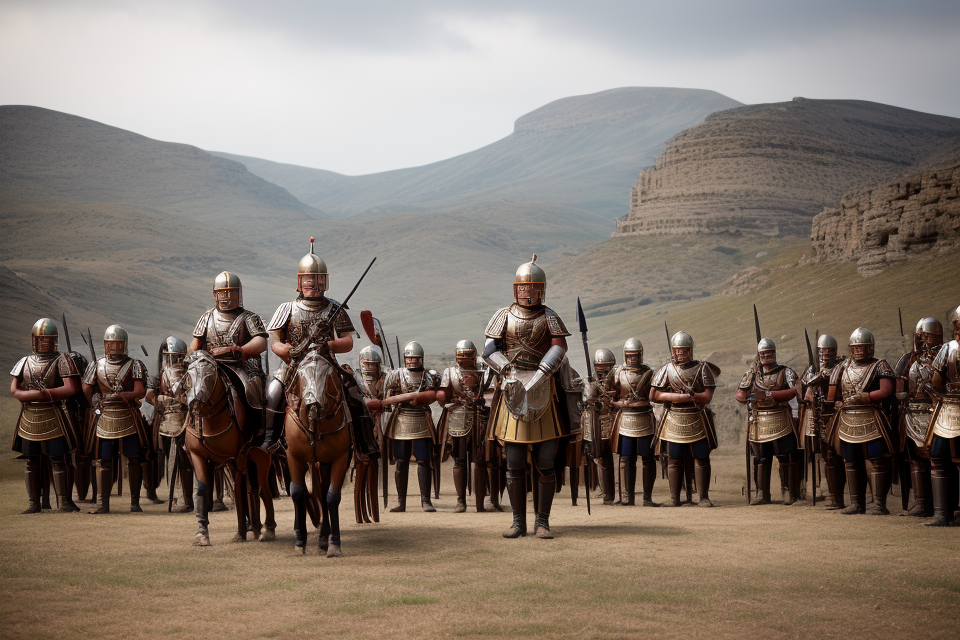
Uniforms have been a part of human history for centuries, with various reasons for their invention. From military to sports teams, school to workplaces, uniforms have been used to represent identity, authority, and a sense of belonging. But have you ever wondered why uniforms were invented in the first place? This article takes a comprehensive look into the origins and purpose of uniforms, exploring the reasons behind their creation and the impact they have had on society. Join us as we delve into the fascinating world of uniforms and discover why they have become an integral part of our lives.
Uniforms were invented for a variety of reasons, including identifying individuals and groups, maintaining order and discipline, and creating a sense of unity and belonging. The earliest recorded use of uniforms dates back to ancient civilizations, where they were used to distinguish soldiers and officials from the general population. Over time, uniforms have evolved to serve a variety of purposes, including identifying professionals, such as police officers and firefighters, and representing organizations, such as sports teams and corporations. In many cases, uniforms are also used to protect the wearer from the elements or hazardous conditions. Today, uniforms continue to play an important role in society, helping to identify individuals and groups, maintain order and discipline, and foster a sense of unity and pride.
The History of Uniforms
Ancient Civilizations and Military Uniforms
Ancient Egyptian Military Uniforms
Ancient Egypt was one of the earliest civilizations to adopt military uniforms. The uniforms were primarily used to distinguish soldiers from civilians and to promote a sense of unity and discipline among the troops. The uniforms were simple but effective, consisting of a kilt-like garment made of linen or leather, and a headdress that identified the soldier’s rank and unit. The headdress also served as protection for the head and neck.
Ancient Greek and Roman Military Uniforms
Ancient Greece and Rome also had military uniforms, which were used to identify soldiers and distinguish them from the enemy. Greek soldiers, for example, wore a hoplite’s armor, which consisted of a metal helmet, breastplate, and greaves (leg armor). Roman soldiers, on the other hand, wore a metal helmet, breastplate, and leg armor, as well as a cloak to identify their unit. The Roman army was also known for its distinctive uniforms, such as the red tunics worn by the legionnaires.
Medieval Europe Military Uniforms
During the Middle Ages, military uniforms continued to evolve in Europe. Knights, for example, wore armor that was both practical and stylish, with colorful designs and symbols that identified their rank and allegiance. Foot soldiers, on the other hand, wore simpler uniforms, such as a tunic and leggings, which were more practical for battle. The uniforms also served as a means of identification, as soldiers from different countries and units often wore different colors and designs.
Uniforms in the Modern Era
The Rise of National Armies
The modern era saw the rise of national armies, and with it, the need for standardized uniforms. Uniforms became a way for soldiers to identify with their respective nations and for officers to distinguish themselves from their men. This led to the development of distinctive uniforms that represented each country’s military, complete with insignia and rank distinctions.
The Impact of Industrialization on Uniform Design
The Industrial Revolution brought about significant changes in the way uniforms were designed and produced. Mass production techniques made it possible to produce uniforms on a large scale, which was crucial for the growing armies of the time. The availability of synthetic materials like polyester and nylon also allowed for greater flexibility in uniform design, enabling the creation of more functional and comfortable garments.
The Development of Standardized Uniforms
As armies became more professionalized, there was a growing need for standardized uniforms that would ensure consistency and efficiency. Standardized uniforms allowed for easier identification of soldiers and made it easier to maintain discipline and order within the ranks. The development of standardized uniforms was also influenced by the need for practicality, as uniforms had to be designed to meet the specific needs of soldiers in the field. This led to the creation of uniforms that were functional, durable, and easy to maintain, with features like reinforced seams, sturdy zippers, and moisture-wicking fabrics.
The Purpose of Uniforms
Uniforms in the Military
Uniforms have been a staple in the military for centuries, serving multiple purposes that are essential to the functioning of a well-organized and effective military force.
Camouflage and Identification
One of the primary purposes of military uniforms is camouflage. The idea behind camouflage is to make soldiers less visible to the enemy, thus reducing the likelihood of being targeted. Military uniforms are designed to blend in with the environment, making it difficult for the enemy to distinguish between friendly and enemy forces. This is particularly important in combat situations where soldiers need to remain hidden and avoid detection.
Identification is another important aspect of military uniforms. It is essential for soldiers to be easily identifiable to their fellow comrades in arms. Military uniforms typically include insignia, such as rank, unit, and branch of service, which help to identify soldiers and facilitate communication within the military hierarchy. This is particularly important in large-scale operations where coordination and communication are critical to success.
Discipline and Unit Cohesion
Military uniforms also serve to promote discipline and unit cohesion. The wearing of a uniform is a symbol of belonging to a larger organization and is an indication of commitment to the military and its values. Wearing a uniform helps to instill a sense of pride and identity in soldiers, fostering a sense of loyalty and commitment to the military and its mission.
In addition, the wearing of a uniform promotes discipline by establishing a standard of dress that all soldiers are expected to adhere to. This helps to maintain a professional and organized appearance, which is essential for military effectiveness. Uniforms also help to promote a sense of unity and belonging among soldiers, fostering a sense of camaraderie and teamwork that is essential for successful military operations.
Overall, the wearing of military uniforms serves several important purposes, including camouflage, identification, discipline, and unit cohesion. These factors are essential to the effectiveness of a military force and contribute to the overall success of military operations.
Uniforms in the Workplace
Uniforms have been a staple in the workplace for centuries, serving various purposes that contribute to the overall functioning of the work environment. From promoting professionalism and identification to ensuring safety and health regulations, uniforms play a crucial role in creating a cohesive and efficient workplace.
Professionalism and Identification
One of the primary purposes of uniforms in the workplace is to promote a sense of professionalism among employees. By wearing a uniform, employees are instantly recognizable as part of a particular organization, creating a sense of unity and belonging. This helps to establish a professional image for the company, which can have a positive impact on customer perception and overall brand reputation.
Additionally, uniforms can help to identify different roles and responsibilities within an organization. For instance, doctors and nurses in a hospital wear different colored scrubs to denote their respective roles, making it easier for patients and visitors to identify them. This can be especially helpful in emergency situations where quick identification of medical personnel is critical.
Safety and Health Regulations
Another significant purpose of uniforms in the workplace is to ensure safety and health regulations are met. Uniforms can be designed with specific safety features, such as reflective materials for workers in hazardous environments or protective gear for employees working with hazardous materials. This helps to minimize the risk of accidents and injuries in the workplace, protecting both employees and the company from potential liability.
Moreover, uniforms can help to promote hygiene and sanitation in the workplace. For example, food service workers wear uniforms to maintain a clean and hygienic environment, reducing the risk of foodborne illnesses. Additionally, uniforms can be designed with features such as fire-resistant materials or non-slip shoes, which can help to prevent accidents and injuries.
In conclusion, uniforms in the workplace serve multiple purposes, including promoting professionalism and identification and ensuring safety and health regulations are met. By implementing a uniform policy, companies can create a more cohesive and efficient work environment, which can have a positive impact on employee morale, customer perception, and overall brand reputation.
The Evolution of Uniform Design
Functionality and Practicality
Uniforms have been designed to serve a specific purpose, which is to provide practicality and functionality to the wearer. This section will delve into the materials and construction techniques used in uniform design, as well as the design elements and symbolism that are often incorporated to convey a message or represent a particular group or organization.
Materials and Construction Techniques
The materials used in uniform design play a crucial role in determining the practicality and durability of the garment. Early uniforms were often made from heavy and sturdy materials such as wool, leather, and linen, which were suitable for the demands of battle and other physically demanding activities. In modern times, materials such as polyester, nylon, and cotton are commonly used due to their lightweight, moisture-wicking, and durable properties.
In addition to the materials used, the construction techniques employed in uniform design also play a significant role in determining their functionality. For example, double-stitching and reinforced seams are often used to increase the durability of uniforms, particularly those that are subjected to frequent wear and tear, such as those worn by athletes or military personnel.
Design Elements and Symbolism
Design elements and symbolism are often incorporated into uniform design to convey a message or represent a particular group or organization. For example, the use of specific colors, patterns, and emblems can signify the rank, position, or branch of service of the wearer.
The use of uniforms also serves to create a sense of unity and identity among members of a particular group or organization. For instance, the use of a common uniform can help to foster a sense of belonging and loyalty among members of a sports team, military unit, or corporation.
Overall, the functionality and practicality of uniform design have played a crucial role in its evolution over time. From the materials and construction techniques used to the design elements and symbolism incorporated, uniforms have been designed to meet the specific needs and demands of their wearers, whether for physical protection, identification, or a sense of unity and belonging.
Customization and Personalization
Customization and personalization have played a significant role in the evolution of uniform design. From ancient times to the modern era, uniforms have been designed to reflect rank and status, cultural and regional differences, and personal preferences.
Rank and Status
In ancient times, uniforms were used to indicate rank and status. For example, in ancient Rome, the military wore uniforms that identified their rank and unit. Similarly, in medieval Europe, knights wore armor that reflected their social status and rank. This tradition of using uniforms to indicate rank and status has continued into modern times, with police officers, firefighters, and other public servants wearing uniforms that reflect their position and authority.
Cultural and Regional Differences
Uniforms have also been designed to reflect cultural and regional differences. For example, in some countries, traditional dress is worn as a form of uniform. In Japan, the kimono is a traditional garment that is often worn as a form of school uniform. Similarly, in India, the saree is a traditional garment that is often worn as a form of work uniform in some industries.
In addition to reflecting cultural and regional differences, uniforms have also been designed to allow for personalization. Many organizations allow employees to personalize their uniforms with patches, pins, and other insignia. This allows individuals to express their personal style while still adhering to the guidelines of the organization.
Overall, the evolution of uniform design has been shaped by a need to reflect rank and status, cultural and regional differences, and personal preferences. As society continues to evolve, so too will the design of uniforms, with new materials, styles, and designs emerging to meet the changing needs of individuals and organizations.
The Future of Uniform Design
Technology and Innovation
As technology continues to advance, the future of uniform design is poised to be shaped by innovative materials and production techniques. Some of the key trends in this area include:
- Smart Textiles: The integration of sensors and other electronic components into fabrics is allowing for the creation of “smart” uniforms that can monitor the wearer’s biometric data, such as heart rate and body temperature. This technology has the potential to enhance the performance of athletes and military personnel, as well as improve the safety of workers in hazardous environments.
- 3D Printing: The use of 3D printing technology in the production of uniforms is allowing for greater customization and personalization. This technique enables designers to create intricate patterns and shapes that would be difficult or impossible to achieve using traditional manufacturing methods.
- Sustainable Materials: There is a growing trend towards the use of sustainable and eco-friendly materials in uniform design. This includes the use of organic cotton, recycled polyester, and other materials that are renewable and have a lower environmental impact.
Sustainability and Ethical Considerations
As society becomes increasingly aware of the environmental and social impact of fashion, sustainability and ethical considerations are becoming more important in the design of uniforms. Some of the key issues in this area include:
- Labor Standards: Many companies are working to ensure that their uniforms are produced in factories that meet high standards for labor practices, including fair wages and safe working conditions.
- Material Sourcing: There is a growing awareness of the environmental impact of material sourcing, and many companies are working to use materials that are sustainably sourced and have a lower carbon footprint.
- End-of-Life Disposal: The disposal of uniforms is also an important consideration, and many companies are working to ensure that their uniforms can be recycled or repurposed at the end of their lifecycle.
Overall, the future of uniform design is likely to be shaped by a combination of technological innovation and sustainability considerations. As society becomes more conscious of the impact of fashion on the environment and society, it is likely that the design of uniforms will become increasingly focused on sustainability and ethical considerations.
The Continuing Relevance of Uniforms in Society
In modern times, uniforms continue to play a significant role in various aspects of society. They serve as a symbol of identity, a means of establishing order and hierarchy, and a way to communicate professionalism and authority. The following are some of the ways in which uniforms remain relevant in contemporary society:
- Identity and belonging: Uniforms help individuals identify with a particular group or organization, fostering a sense of belonging and camaraderie. They can also help individuals differentiate themselves from others and establish a distinct identity within their social context.
- Professionalism and authority: Uniforms are often used to convey a sense of professionalism and authority, particularly in fields such as law enforcement, healthcare, and military. The uniform can signify to others that the wearer is in a position of authority and responsibility, and it can also reinforce the wearer’s own sense of professional identity.
- Safety and protection: In certain industries, uniforms are designed to provide protection and safety to the wearer. For example, construction workers may wear reflective vests to increase visibility and reduce the risk of accidents, while healthcare workers may wear personal protective equipment to guard against the spread of infectious diseases.
- Social status and power dynamics: Uniforms can also serve as a symbol of social status and power dynamics within a society. For instance, formal uniforms worn by waiters or other service staff in restaurants can signal to customers that the wearer holds a position of authority or expertise within the establishment. Similarly, the uniforms worn by security personnel or government officials can convey a sense of power and control over a particular space or situation.
Overall, the continued relevance of uniforms in society can be attributed to their ability to serve as a symbol of identity, authority, and professionalism, as well as their role in promoting safety and protection in various industries.
The Importance of Understanding Uniform History and Design
When examining the origins and purpose of the uniform, it is essential to delve into its history and design. The history of uniforms dates back to ancient times, and their design has evolved significantly over the centuries. Understanding the evolution of uniform design can provide valuable insights into why uniforms were invented and how they have adapted to meet the changing needs of society.
One reason it is important to understand the history and design of uniforms is that they are often a reflection of the social and cultural norms of the time. Uniforms have been used to symbolize power, authority, and social status throughout history. By studying the history of uniforms, we can gain a better understanding of the societal values and beliefs that have influenced their design.
Another reason to study the history and design of uniforms is that they have often been used as a means of identification and communication. In the past, uniforms were used to distinguish soldiers from civilians, or to identify members of different social classes or professions. By examining the design of these uniforms, we can gain insight into the importance of identification and communication in the development of the uniform.
Additionally, understanding the history and design of uniforms can help us appreciate the functional aspects of their design. Uniforms have been designed to meet specific practical needs, such as providing protection or facilitating movement. By examining the history of uniform design, we can better understand the functional considerations that have influenced the design of uniforms over time.
Overall, understanding the history and design of uniforms is crucial to understanding their origins and purpose. By examining the evolution of uniform design, we can gain a better appreciation for the social, cultural, and practical factors that have influenced the development of the uniform.
The Future of Uniforms and Their Potential Impact on Society
The future of uniforms holds many possibilities, as advancements in technology and changes in societal values continue to shape their design and function. Some potential developments in uniform design include:
- Personalized Uniforms: With the advancement of technology, it may become possible to create uniforms that are tailored to an individual’s body measurements and personal preferences. This could lead to increased comfort and improved performance for the wearer.
- Smart Uniforms: Uniforms equipped with sensors and other smart technology could monitor a person’s vital signs, track their movements, and provide real-time feedback on their performance. This could be particularly useful in industries such as healthcare and sports.
- Eco-Friendly Uniforms: As sustainability becomes a greater concern, there may be a shift towards creating uniforms made from eco-friendly materials. This could include using organic cotton, recycled polyester, and other materials that have a lower environmental impact.
- Virtual Reality Uniforms: In the future, it is possible that uniforms could be designed to work with virtual reality technology. This could allow for enhanced training and simulation experiences, as well as new forms of entertainment and communication.
Overall, the future of uniforms is likely to be shaped by a combination of technological advancements and changing societal values. As these developments continue to unfold, it will be important to consider the potential impacts on individuals and society as a whole.
FAQs
1. Why was the uniform invented?
The uniform was invented for a variety of reasons, including practicality, identification, and social status. In ancient times, uniforms were used to identify soldiers and differentiate them from civilians. Over time, the use of uniforms expanded to other professions, such as law enforcement and the military. Uniforms also serve as a symbol of authority and a way to establish a sense of order and discipline.
2. When was the first uniform invented?
The exact origins of the uniform are difficult to pinpoint, as it has been used in various forms throughout history. However, some of the earliest recorded use of uniforms dates back to ancient civilizations, such as the Romans and Greeks, who used uniforms to identify soldiers and differentiate them from civilians.
3. Who invented the uniform?
The uniform was not invented by a single person, but rather developed over time by various cultures and societies. It is difficult to attribute the invention of the uniform to any one person, as it has been used in various forms throughout history.
4. What is the purpose of a uniform?
The purpose of a uniform is to identify a person as belonging to a particular profession or organization. Uniforms also serve as a symbol of authority and a way to establish a sense of order and discipline. In addition, uniforms can help to promote a sense of unity and belonging among members of an organization.
5. Why do police officers wear uniforms?
Police officers wear uniforms for a variety of reasons, including identification, protection, and as a symbol of authority. The uniform helps to identify police officers as members of law enforcement and differentiate them from civilians. The uniform also provides a level of protection for police officers, as it is typically designed to be durable and provide some level of protection against physical harm. Additionally, the uniform serves as a symbol of authority and helps to establish a sense of order and discipline.
6. Why do soldiers wear uniforms?
Soldiers wear uniforms for a variety of reasons, including identification, protection, and as a symbol of unity and belonging. The uniform helps to identify soldiers as members of the military and differentiate them from civilians. The uniform also provides a level of protection for soldiers, as it is typically designed to be durable and provide some level of protection against physical harm. Additionally, the uniform serves as a symbol of unity and helps to establish a sense of order and discipline among members of the military.
7. Why do school students wear uniforms?
School students wear uniforms for a variety of reasons, including identification, safety, and as a symbol of unity and belonging. The uniform helps to identify students as members of a particular school and differentiate them from students at other schools. The uniform also provides a level of safety for students, as it is typically designed to be durable and provide some level of protection against physical harm. Additionally, the uniform serves as a symbol of unity and helps to establish a sense of order and discipline among members of the school community.


